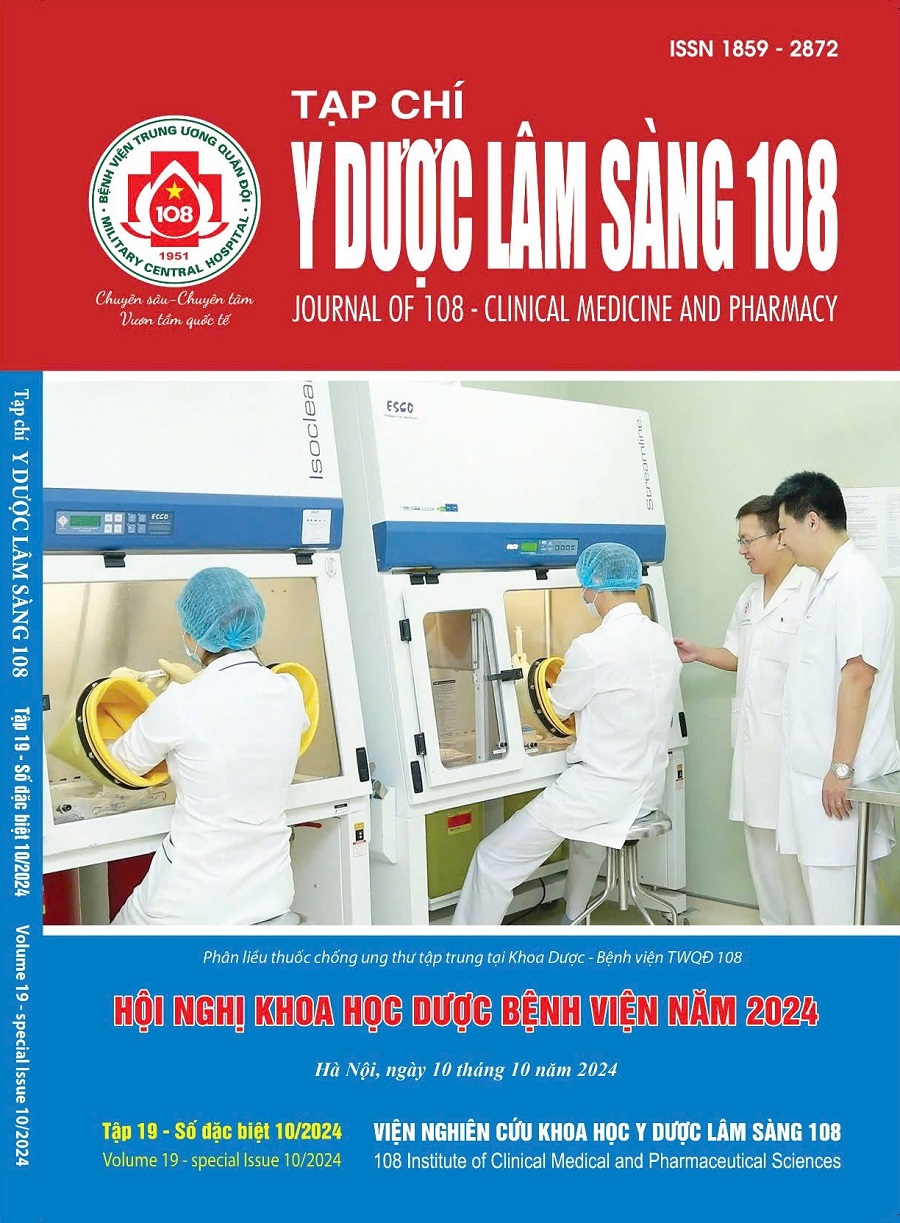An analysis of intravenous linezolid utilization at 108 Military Central Hospital
Main Article Content
Keywords
Abstract
Objective: To analyze the current status of linezolid use at 108 Military Central Hospital. Subject and method: A retrospective study of DDDs per 100 bed-days over 5 years (from 2019 to 2023) and medical records of inpatients treated with linezolid from April 1, 2022 to March 31, 2023. Result: Linezolid consumption significantly increased during the study period (S = 1044, p<0.001). Over a year, 343 linezolid episodes corresponding to 336 inpatients were included. Linezolid used in empiric regimens (59.1%), within label-use for linezolid (66.2%). We recorded 153 cases (44.6%) of inappropriate indications, primarily due to unsatisfactory use as an alternative to vancomycin (34.6%) and bacterial pathogens not within linezolid's treatment scope (24.2%). We recorded 153 cases (44.6%) of inappropriate indications, primarily due to unsatisfactory use as an alternative to vancomycin (34.6%) and bacterial pathogens not within linezolid's treatment scope (24.2%). Thrombocytopenia was the most commonly reported adverse event (24.9%), and 101 patients experienced drug interactions contraindicated with linezolid. Conclusion: Linezolid consumption in 2019-2023 tends to increase, and a high proportion of patients use linezolid with antibiotic indications that are not completely appropriate. Early issuance of protocol for the use of linezolid is necessary because it is a reserve antibiotic, especially when antibiotic resistance to vancomycin is on the rise.
Article Details
References
2. Brown NM, Goodman AL, Horner C, Jenkins A, Brown EM (2021) Treatment of methicillin-resistant Staphylococcus aureus (MRSA): Updated guidelines from the UK. JAC Antimicrob Resist 3(1):dlaa114. doi: 10.1093/jacamr/dlaa114.
3. Đoàn Thị Phương, Lê Vân Anh và cộng sự (2016) Khảo sát sử dụng kháng sinh linezolid tại Bệnh viện Bạch Mai. Tạp chí Nghiên cứu Dược và Thông tin Thuốc. 4+5(7), tr. 184-188.
4. Dentan C, Forestier E, Roustit M, Boisset S, Chanoine S, Epaulard O, Pavese P (2017) Assessment of linezolid prescriptions in three French hospitals. Eur J Clin Microbiol Infect Dis 36(7): 1133-1141.
5. Bộ Y tế (2020) Hướng dẫn thực hiện quản lý sử dụng kháng sinh trong bệnh viện. Ban hành kèm theo Quyết định 5631/QĐ-BYT ngày 31 tháng 12 năm 2020.
6. WHO Collaborating Centre for Drug Statistics Methodology (2024), ATC/DDD Index 2024, accessed, from https://atcddd.fhi. no/atc_ddd_index_and_guidelines/guidelines/.
7. Han X, Wang J, Zan X, Peng L, Nie X (2022) Risk factors for linezolid-induced thrombocytopenia in adult inpatients. Int J Clin Pharm 44(2): 330-338.
8. Qin Y, Liu Y, Chen Z, Cao M, Shen Y, Ye Y (2021) A risk factor-based predictive model for linezolidinduced anaemia: A 7-year retrospective study. J Clin Pharm Ther 46(6): 1591-1599.
9. Gerson SL, Kaplan SL et al (2002) Hematologic effects of linezolid: Summary of clinical experience. Antimicrob Agents Chemother 46(8): 2723- 2726.
10. Đặng Thị Lan Anh, Võ Thị Thùy, Nguyễn Thị Mai Anh và cộng sự (2021) Phân tích thực trạng sử dụng linezolid tại Bệnh viện Thanh Nhàn. Tạp chí Y dược lâm sàng 108. 16(11), tr. 110-118.
11. Pitiriga V, Kanellopoulos P, Kampos E, Panagiotakopoulos G, Tsakris A, Saroglou G (2018) Antimicrobial stewardship program in a Greek hospital: Implementing a mandatory prescription form and prospective audits. Future Microbiol 13: 889-896.
12. Meyer E, Schwab F, Schroeren-Boersch B, Gastmeier P (2011) Increasing consumption of MRSA-active drugs without increasing MRSA in German ICUs. Intensive Care Medicine 37(10): 1628-1632.
13. Grau S, Fondevilla E, Freixas N, Mojal S, Sopena N, Bella F, Gudiol F; VINCat Group (2015) Relationship between consumption of MRSA-active antibiotics and burden of MRSA in acute care hospitals in Catalonia, Spain. Journal of Antimicrobial Chemotherapy 70(4): 1193-1197.
14. Aubin G, Lebland C, Corvec S, Thomaré P, Potel G, Caillon J, Navas D (2011) Good practice in antibiotic use: what about linezolid in a French university hospital?. Int J Clin Pharm 33(6): 925-928.
15. Thi Phuong Thao L, Duc Trung N, Thi My L, Minh Hong L, Viet Hoan B, Quang Hung V, Dang Hai P (2024) Association of clinical factors with thrombocytopenia in patients receiving linezolid treatment: A retrospective study. J Infect Dev Ctries 18(2): 285-290.
16. Choi GW, Lee JY, Chang MJ, Kim YK, Cho Y, Yu YM, Lee E (2019) Risk factors for linezolid-induced thrombocytopenia in patients without haemato-oncologic diseases. Basic Clin Pharmacol Toxicol 124(2): 228-234.
 ISSN: 1859 - 2872
ISSN: 1859 - 2872
